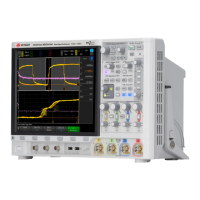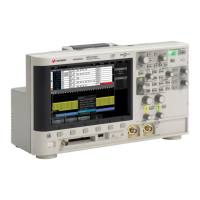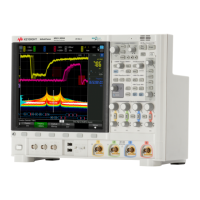:WAVeform Commands 36
Keysight InfiniiVision 4000 X-Series Oscilloscopes Programmer's Guide 1399
There are three formats for transferring waveform data over the interface: BYTE,
WORD and ASCii (see ":WAVeform:FORMat" on page 1405). BYTE, WORD and
ASCii formatted waveform records are transmitted using the arbitrary block
program data format specified in IEEE 488.2.
When you use the block data format, the ASCII character string "#8<DD...D>" is
sent prior to sending the actual data. The 8 indicates how many Ds follow. The Ds
are ASCII numbers that indicate how many data bytes follow.
For example, if 1000 points will be transferred, and the WORD format was
specified, the block header "#800001000" would be sent. The 8 indicates that
eight length bytes follow, and 00001000 indicates that 1000 binary data bytes
follow.
Use the :WAVeform:UNSigned command (see page 1423) to control whether data
values are sent as unsigned or signed integers. This command can be used to
match the instrument's internal data type to the data type used by the
programming language. This command has no effect if the data format is ASCii.
Data Format for Transfer - ASCii format
The ASCii format (see ":WAVeform:FORMat" on page 1405) provides access to
the waveform data as real Y-axis values without using Y origin, Y reference, and
Y increment to convert the binary data. Values are transferred as ASCii digits in
floating point format separated by commas. In ASCii format, holes are
represented by the value 9.9e+37. The setting of :WAVeform:BYTeorder (see
page 1401) and :WAVeform:UNSigned (see page 1423) have no effect when
the format is ASCii.
Data Format for Transfer - WORD format
WORD format (see ":WAVeform:FORMat" on page 1405) provides 16-bit
access to the waveform data. In the WORD format, the number of data bytes is
twice the number of data points. The number of data points is the value
returned by the :WAVeform:POINts? query (see page 1406). If the data
intrinsically has less than 16 bits of resolution, the data is left-shifted to provide
16 bits of resolution and the least significant bits are set to 0. Currently, the
greatest intrinsic resolution of any data is 12 bits, so at least the lowest 4 bits of
data will be 0. If there is a hole in the data, the hole is represented by a 16 bit
value equal to 0.
Use :WAVeform:BYTeorder (see page 1401) to determine if the least significant
byte or most significant byte is to be transferred first. The :BYTeorder command
can be used to alter the transmit sequence to match the storage sequence of
an integer in the programming language being used.
Data Format for Transfer - BYTE format
The BYTE format (see ":WAVeform:FORMat" on page 1405 ) allows 8-bit
access to the waveform data. If the data intrinsically has more than 8 bits of
resolution (averaged data), the data is right-shifted (truncated) to fit into 8 bits.

